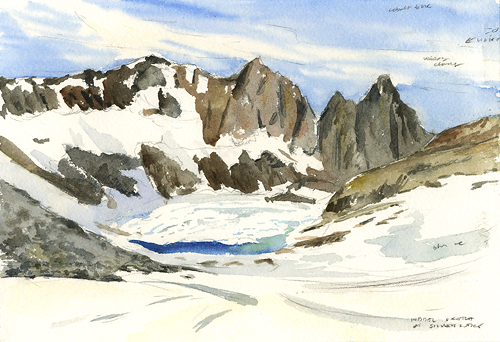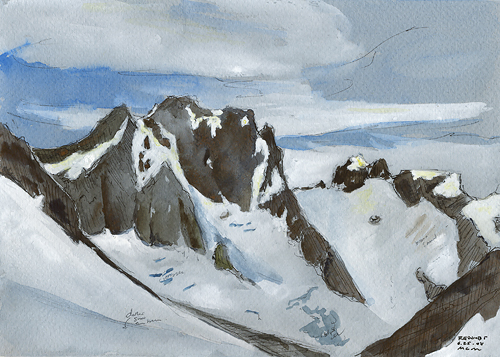Silver Glacier
I’m catching my breath after a busy past few weeks which have included moving from Bainbridge to Seattle, teaching a nature journaling workshop, and now I’m just returned from a wonderful trip to the mountains. This week I had the privilege of accompanying North Cascades National Park scientists up to Silver Glacier on the flanks of Mt. Spickard in the North Cascades, just along the Canadian-US Border.
North Cascades Park has over 300 glaciers which serve as a bank account of sorts for the region’s water and are essential for ecosystems and our drinking water supply. Four glaciers in the park were selected for monitoring in 1993, each draining into a different watershed. I learned about the Park’s monitoring two years ago when I first met the program’s chief investigator Jon Riedel. Jon was interested and supporting of my work and in considering places to paint, he encouraged me to visit Silver Glacier with his team. Like all of the glaciers monitored, Silver Glacier is receding. If you’re interested in the full results, check out the report here. As an artist, I’m working to contributing to the visual record of these changing regions, and I love the challenge of plein air sketching sur glace.
So Tuesday I drove up to Sedro Woolley to meet Steve and Jeanna in a large blue government owned Tahoma truck. To access Silver glacier, we drove north into Canada to the Chilliwack Lake area and down various logging roads where we finally left the truck. The border crossing into the woods was interesting – in the middle of the young woods (a 20 ft swath of forest was originally cleared along the whole border and is now growing back in select wilderness areas) is a pinnacle demarcating the Canadian and US sides with a border guard waiting to check passports. Ok, no guard, but there is a pinnacle. The trail continues in America as an unmaintained climber’s trail that meanders up Deport Creek, ascends (rather dramatically next to a waterfall) to a cirque basin, and leads to the base of Redoubt Mountain and Mt. Spickard. It’s beautiful and the views felt earned after the hours of bush whacking and clambering over trees and rocks.
We spent the night next to the small “Ouzel Lake” and the following day hiked up to Silver Lake and Glacier. It was a spectacular day and while Jeanna and Steve probed several points along the glacier, I managed to sketch out several small watercolors and feel it was a productive trip. We were also lucky with the weather and stayed dry the whole time! On the painting note, my field kit evolves every time I take a trip. This time I brought ~10 sheets of Arches 140lb cold press paper, Canson Mi-tientes blues and tans, and also chopped the ends of several of my paint brushes so that they would fit well in a compact sack with a small palette loaded with 12 watercolors. Additionally, I carried a small pamphlet book that I made for small ink studies which fit conveniently in my pocket with one waterproof pen, one water-soluble pen, and one water brush. I’ve included some results below.
I’m now looking forward to developing my field work and considering ways in which I might incorporate the data collected by scientists into my work. Any suggestions are welcome and check back for work in progress! Thank you again to Jon Riedel, Jeanna, and Steve for sharing their work with me and for the fantastic time in the mountains.



Leave a Reply